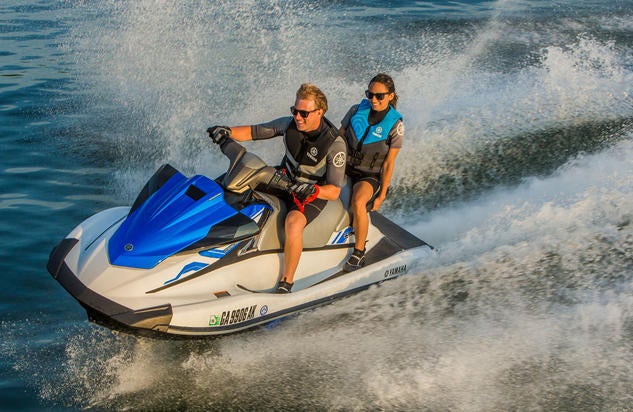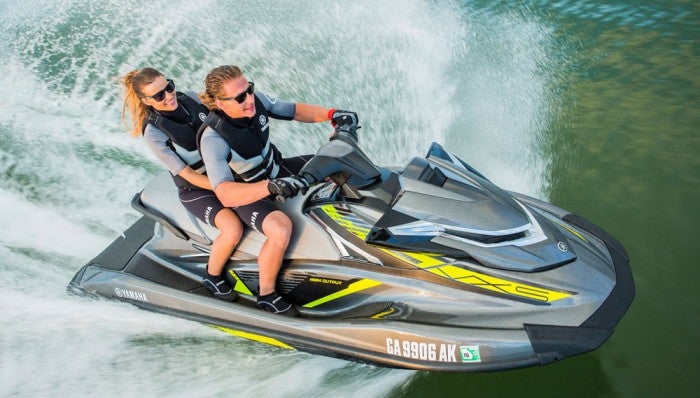2015 Yamaha VX and V1 Lineup Review
New V1 series and big upgrades for best-selling VX line
“If it aint’ broke, don’t fix it.”
It’s certainly been a tempting mantra for Yamaha when it comes to the competitively priced VX line. Since the VX’s inception in 200X, one of the models has been not only Yamaha’s best-seller, but the best-selling personal watercraft in the entire industry.
Every…single…year.
True, there were some minor modifications a few years back, but all in all, the VX has remained the same basic craft. Which makes sense. Why mess with a good thing? The answer, however, is that you inevitably have to. And spurred in part by Sea-Doo’s Spark, as well as changes within their own target market, that “messing” has now revealed two new product lines within the brand’s hierarchy.
A New, More Refined VX
 A new hull and deck offer the VX line a more sleek and angular appearance.
A new hull and deck offer the VX line a more sleek and angular appearance.The first is branded, what else, the VX. This VX, however, is not the VX of old but rather a complete retooling of the craft from top to bottom.
Yamaha Introduces Dual-Lever “RIDE” Controls
Or at least, a complete retooling of the hull and deck. While the engine within remains the familiar 1,052cc engine that has powered the VX line from the start, the exterior now reflects a decidedly more upscale positioning reminiscent of the FX series. Starting with the deck, lines are more sleek and angular than in year’s past, with the mirrors and bow storage stylishly integrated into a triangular-shaped wedge. The saddle gets the two-piece, cut-and-sew treatment, while the rear deck gains more real estate. Overall length increases by more than 4”, and width by almost 2”.
 Yamaha’s new dual-throttle RIDE system can be found throughout the 2015 VX line.
Yamaha’s new dual-throttle RIDE system can be found throughout the 2015 VX line.Look closer and you’ll likewise note a new level of refinement, highlighted by the inclusion of Yamaha’s dual-throttle RIDE system throughout the line. RIDE adds a lefthand throttle lever to control the craft’s thrust and reverse bucket simultaneously, allowing the driver to rapidly slow the craft when desired, back up with eyes on the water and hands on the handlebars, and control the craft in tight, slow-speed situations like docking with true forward, neutral, and reverse capability.
All models get sleek new instrumentation and chrome accents. The Cruiser and Deluxe models add cruise control and a no-wake mode, in addition to a tiered, bolstered touring-style saddle for the Cruiser.
 The VX Cruiser benefits from a tiered, bolstered touring-style seat.
The VX Cruiser benefits from a tiered, bolstered touring-style seat.The hull below also reflects new thinking. In fact, Yamaha Product Manager Scott Watkins proclaims it one of, if not the best hull the brand has ever done. Specific changes include a new rounder keel, modified strakes and softer chines, coupled with an all new intake and rideplate. It feels quicker and sportier on the water than the VX of old (particularly when paired with the more powerful engine of the VXR and VXS performance models).
It’s clear the VX refresh puts these models beyond the simple introductory buyer. Instead, the line now takes on a more mid-level positioning that’s reflected in their price tags. The simply titled VX will now sell for $9,299, followed by the VX Deluxe at $9,999 and the VX Cruiser at $10,299.
The New V1
 Yamaha is targeting entry level buyers with the new V1 line – essentially last year’s VX models with the old hull and deck.
Yamaha is targeting entry level buyers with the new V1 line – essentially last year’s VX models with the old hull and deck.So what models, then, will attract the true entry-level buyer? That task falls to the new V1 line…or essentially the VX models of old.
COMPARISON: Read our review of the 2014 Yamaha VX Sport
While some industry types may have been predicting Yamaha would venture into Sea-Doo Spark territory with a dramatically lower-priced model, company officials reveal that their research shows that most entry buyers are still paying in the neighborhood of $7-8,000. (In fact, the average price paid for a Spark was reportedly $7,319.) In short, if consumers are buying Sparks, they’re optioning them up into higher price points. Yamaha’s contention is that consumers want features they can use and are very willing to pay for them, so why trot out a new model when an existing one can still get the job done. V1s are also touted as a perfect choice for those considering a pre-owned watercraft.
 The V1 Sport benefits from a reboarding step and Yamaha’s mechanical reverse.
The V1 Sport benefits from a reboarding step and Yamaha’s mechanical reverse.The V1 line consists of the V1 ($7,699) and V1 Sport ($8,499). Models include the features the previous VX was known for, including compression-molded, glossy SMC hulls, the 1,052 cc Yamaha marine engine, open-loop cooling, Hydro-Turf mats, and 15-gallon storage that includes a large glove box with dual cup holders in addition to the normal bow tub. The jump to the Sport model adds a reboarding step and Yamaha’s traditional, non-electronic reverse with its “mechanical neutral”.
VX High-Performance Models
 Already fun and sporty performers, the VXR and VXS really benefit from the upgraded hull and deck.
Already fun and sporty performers, the VXR and VXS really benefit from the upgraded hull and deck.As previously stated, the new hull design truly enlivens the VX’s high-performance cousins – the two-passenger VXR and VXS. Long touted as models that offered flagship-level muscle performance without the added expense of a supercharger and intercooler, the two craft are now even more potent thanks to the more spirited handling.
COMPARISON: Read our review of the 2014 Yamaha VXS
The VXR and VXS also get the RIDE treatment, as well as a welcome, all-new electronic five-position trim.
 Unlike the rest of the VX line, the VXR and VXS are powered by Yamaha’s 1.8-liter high-performance engine.
Unlike the rest of the VX line, the VXR and VXS are powered by Yamaha’s 1.8-liter high-performance engine.For 2015, the race-inspired two-seat VXR will retail for $11,799, while the three-passenger VXS adds towing and three-passenger ability while dropping the price $300. Both are powered by Yamaha’s largest, 1.8-liter high-performance engine.
Get PersonalWatercraft.com in your Inbox!
Like PersonalWatercraft.com on Facebook
Comments
Most Popular

2025 Yamaha JetBlaster PRO 2-Up Review

Remembering the Sea-Doo XP

2024 Kawasaki Jet Ski STX 160X Review

2024 Yamaha GP HO Review

2017 Kawasaki Jet Ski Ultra 310LX Review













 Your Privacy Choices
Your Privacy Choices